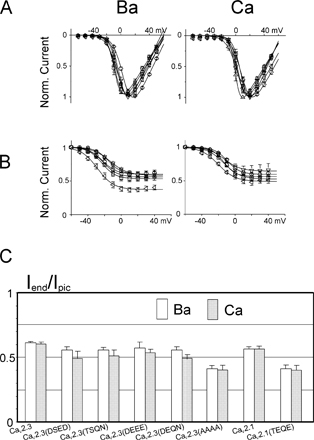
[View Larger Version of this Image]
Figure S3. Mutations at the DCS locus do not affect channel gating. (A)Current-voltage curves obtained with the different CaV2.3 mutants coexpressed with α2-δ and β2a subunits in the presence of 10 mM Ba2+ (left) or Ca2+ (right). CaV2.3(TEQE), square; CaV2.3(DEEE), circle; CaV2.3(DSED), triangle; CaV2.3(DEQN), inverted triangle; CaV2.3(TSQN), diamond; CaV2.3(AAAA), sideway triangle. See also Tables S2 and S3. (B) Isochronal inactivation curves (conditioning pulse of 2.5 s duration) obtained with the different CaV2.3 mutants coexpressed with α2-δ and β2a subunits in the presence of 10 mM Ba2+ (left) or Ca2+ (right). See also Tables S2 and S3. The only noticeable difference is the larger inactivation recorded with the CaV2.3(AAAA) mutant. This modification cannot explain the monotonic decrease of the AMF because (a) this occurred without any modification of the activation parameters and the inactivation kinetics, and (b) the CaV2.3(GGGG), which has the same potentials for half activation and inactivation as the wild type, also displays monotonic AMF with smaller ICa/IBa ratio, suggesting that change in inactivation and cation selectivity are not related. (C) Time course of inactivation of these mutant channels recorded in Ba2+ or Ca2+ solutions and quantified as the fractional current at 2.5 s (current amplitude at the end of the depolarization divided by the current amplitude at the peak). None of the small differences shown in this graph, between the mutant CaV2.3 channels and between Ba2+ and Ca2+ currents, is statistically significant. The CaV2.1(TEQE) is also shown and has clearly no Ca2+-dependent inactivation.